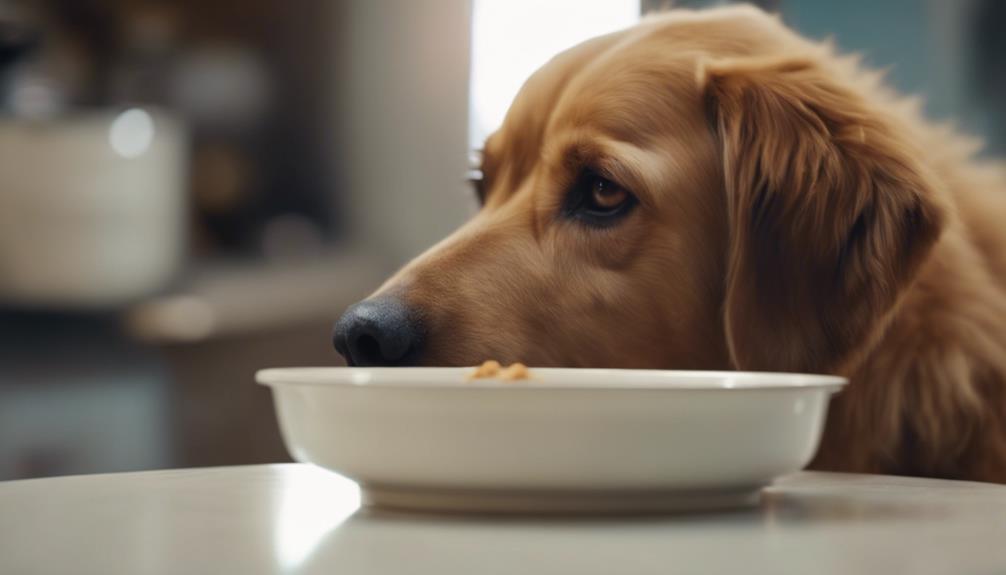Exploring the behavior of dogs desiring hand feeding unveils a fascinating insight into their preferences and well-being. Vets suggest various reasons behind this behavior, ranging from psychological to physiological factors that might influence a dog's inclination towards being hand fed.
By understanding these potential underlying drivers, dog owners can gain a deeper understanding of their canine companions' needs and emotions. The implications of hand feeding extend beyond mealtime routines, offering a unique perspective on the bond between humans and their furry friends.
Key Takeaways
- Separation anxiety or negative experiences can lead dogs to prefer hand feeding.
- Hand feeding can help build trust, reduce resource guarding, and aid training.
- Gradually transition dogs to bowl feeding to establish proper eating habits.
- Consult professionals and consider enrichment strategies to encourage bowl feeding.
Potential Causes of Hand Feeding Preference
In some cases, dogs may develop a preference for hand feeding due to various underlying reasons. These reasons include separation anxiety, mealtime dynamics, negative associations with the food bowl, and a need for attention.
Dogs experiencing separation anxiety, particularly common in rescue dogs, may seek comfort and reassurance through hand feeding. Mealtime dynamics, such as competition with other dogs or conditioned human interactions during feeding, can also influence this preference. Negative associations with the food bowl, stemming from past traumatic events or distractions during mealtime, may lead dogs to avoid eating from it. Additionally, dogs seeking attention or displaying fear and uncertainty may gravitate towards hand feeding as a way to connect with their owners.
Understanding Hand Feeding Benefits
Understanding the benefits of hand feeding for dogs involves recognizing its positive impact on training, behavior modification, and fostering trust between owners and their canine companions. Hand feeding can enhance training sessions by using food as a reward, reinforcing desired behaviors effectively. It also aids in promoting impulse control as dogs learn to wait for their food, thus improving self-discipline.
Furthermore, hand feeding can be instrumental in building trust between dogs and their owners, especially in cases of fearful or shy dogs. By hand feeding, owners establish a close bond with their pets, creating a sense of security and reliability. Overall, incorporating hand feeding into a dog's routine can have numerous advantages in shaping behavior and strengthening the human-canine relationship.
Transitioning Dogs to Bowl Feeding

How can dog owners effectively transition their pets from hand feeding to bowl feeding?
Transitioning dogs to eat from a bowl can be a gradual process that requires patience and consistency. Start by gradually reducing the amount of hand feeding and introducing the bowl during meal times.
Encourage your dog to approach the bowl by placing high-value treats near it. Additionally, consider using puzzle feeders or slow feeders to make the experience more engaging and rewarding for your pet.
It's crucial to remain calm and positive throughout the transition to help your dog feel comfortable and confident with bowl feeding. Consistency, positive reinforcement, and a calm environment are key factors in successfully transitioning your dog to bowl feeding.
Importance of Veterinary Consultation
Why is seeking veterinary consultation crucial when transitioning dogs from hand feeding to bowl feeding?
Veterinary consultation is essential during this transition to rule out any underlying health issues that may be affecting your dog's eating habits. Sudden changes in eating behavior, such as a preference for hand feeding, could be a sign of an underlying medical problem that needs to be addressed promptly. A veterinarian can conduct a thorough examination to ensure your dog is in good health and provide guidance on how to safely transition them to bowl feeding.
Consulting with a vet can also help in developing a tailored feeding plan that meets your dog's nutritional needs and addresses any behavioral concerns that may arise during the transition process.
Addressing Resource Guarding Behavior

In cases of resource guarding behavior in dogs, implementing structured training and behavior modification techniques is crucial for fostering a safe and harmonious environment. Resource guarding can manifest as aggressive behavior when a dog perceives a threat to items like food, toys, or resting places. To address this, it's essential to consult with a professional dog trainer or behaviorist. They can tailor a training plan to help desensitize the dog to perceived threats and teach them positive behaviors.
Techniques may include counterconditioning, where the dog learns that giving up resources leads to rewards, and desensitization, gradually exposing the dog to triggers in a controlled manner. Consistent training, positive reinforcement, and patience are key in modifying resource guarding behavior effectively.
Training Techniques for Mealtime Habits
To establish healthy mealtime habits for dogs, implementing effective training techniques is essential for promoting positive behavior and a structured feeding routine. When transitioning dogs to eat from a bowl, consider the following techniques:
- Work with Professionals: Seek guidance from veterinarians or professional trainers to understand and address hand feeding habits properly.
- Gradual Reconditioning: Alternating between hand feeding and bowl feeding gradually can help dogs become comfortable with eating from a bowl.
- Adjust Feeding Environment: Feeding dogs in separate rooms, changing feeding locations, or adjusting feeding times can encourage bowl feeding and create a positive mealtime experience.
Promoting Healthy Eating Environments

Creating a conducive environment for healthy eating habits in dogs is essential for ensuring their well-being and nutritional balance. It is important to establish a routine that promotes proper mealtime behavior and encourages dogs to eat from their bowls. Here are some key strategies for promoting healthy eating environments:
| Strategies for Promoting Healthy Eating Environments | Benefits |
|---|---|
| Establish a consistent feeding schedule | Helps regulate appetite and digestion |
| Provide a quiet and calm feeding area | Reduces stress and distractions during meals |
| Use appropriate-sized bowls for meals | Prevents discomfort and encourages proper eating habits |
| Avoid free-feeding habits | Encourages dogs to eat at designated meal times |
| Monitor food intake and adjust portions accordingly | Helps maintain a healthy weight and diet balance |
Vet-Approved Nutritional Guidelines
Establishing a foundation of proper nutrition is paramount in maintaining a dog's overall health and well-being, particularly when following vet-approved nutritional guidelines.
When it comes to feeding your canine companion, here are some essential vet-approved nutritional guidelines to consider:
- Balanced Diet: Ensure your dog's diet includes a proper balance of proteins, carbohydrates, fats, vitamins, and minerals to support their overall health.
- Caloric Intake: Consult with your veterinarian to determine the appropriate caloric intake for your dog based on factors like age, weight, and activity level.
- Quality Ingredients: Opt for high-quality dog food brands that use real meat, whole grains, and natural ingredients to promote optimal health and vitality.
Tips for Puppies With Eating Concerns

When addressing eating concerns in puppies, it is essential to observe their behavior during mealtime and consider potential factors affecting their appetite. If a puppy shows reluctance to eat from a bowl, there are strategies to help transition them.
Begin by seeking guidance from professionals and gradually recondition the puppy by alternating between hand feeding and bowl feeding. Feeding the puppy in a separate room can be beneficial if there are issues with other dogs during mealtime. Additionally, adjusting the feeding location or changing feeding times can encourage the puppy to eat from a bowl.
Enriching mealtime with slow feeders, puzzle feeders, or rotating food flavors can also make eating more engaging for puppies with eating concerns.
Weight Management Strategies for Dogs
Addressing weight management in dogs is crucial to their overall health and well-being, especially when considering factors that influence their dietary habits and physical condition. When it comes to managing a dog's weight, here are some effective strategies to consider:
- Balanced Diet: Ensure your dog is receiving a balanced diet tailored to their specific needs, considering factors like age, breed, and activity level.
- Regular Exercise: Incorporate daily exercise routines such as walks, playtime, or interactive toys to help your dog maintain a healthy weight.
- Monitoring Portions: Measure food portions carefully and avoid overfeeding, adjusting the serving size as needed based on your dog's weight and body condition.
Enhancing Mealtime Interaction With Dogs

Enhancing mealtime interaction with dogs can significantly strengthen the bond between pet owners and their canine companions. This can be achieved by incorporating interactive feeding methods such as hand feeding, puzzle feeders, or slow feeders.
Hand feeding not only fosters trust and reinforces training but also helps monitor your dog's eating habits and behavior closely. Engaging in mealtime activities like using different food flavors or feeding in various locations can make the feeding experience more enjoyable and mentally stimulating for dogs.
Additionally, transitioning dogs from hand feeding to bowl feeding gradually can help establish a healthy feeding routine. By enhancing mealtime interaction, pet owners can promote positive behaviors, improve the dog's overall well-being, and deepen the connection with their furry companions.
Conclusion
In conclusion, understanding the potential causes and benefits of hand feeding in dogs can provide valuable insights into their well-being and behavior.
By addressing resource guarding behavior, implementing vet-approved nutritional guidelines, and enhancing mealtime interaction, dog owners can support their canine companions in a way that fosters a deeper bond and promotes overall health.
Consulting with a veterinarian for guidance and support is crucial in navigating this behavior with empathy and knowledge.




